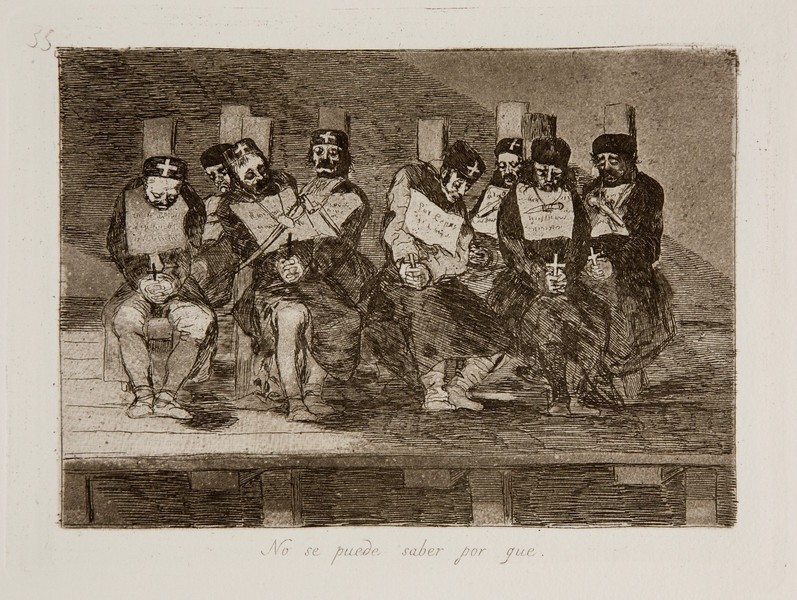- Cronología
- Ca. 1812 - 1815
- Dimensiones
- 154 x 256 mm
- Técnica y soporte
- Etching, burnished lavis, drypoint and burin
- Reconocimiento de la autoría de Goya
- Undisputed work
- Ficha: realización/revisión
- 08 Dec 2010 / 24 May 2023
- Inventario
- 225
2 (on the lower left-hand corner)
See Sad presentiments of what must come to pass (Tristes presentimientos de lo que ha de acontecer).
The title was handwritten on the print by Goya in the first and only series that is known to have been printed at the time the works were created, which the artist gave to his friend Agustín Ceán Bermúdez. Therefore, the title was etched into the plate at a later date and left unchanged as of the first edition of the Disasters of War printed by the San Fernando Royal Academy of Fine Arts in Madrid in 1863, after the printing of the series in the possession of Ceán Bermúdez.
There are no surviving preparatory drawings for this print.
Goya returns to the theme depicted in the previous print, no. 34, On account of a knife (Por una navaja), although in this case the scene shows a mass execution. The compositional space is occupied by a group of men executed by garrotte. All the men's hands are clasped around crucifixes and they wear hats bearing more crosses. Almost all of them have the weapon for which they have been convicted hanging around their necks, excepting the third and last men on the right. Goya wishes to draw the viewer's attention to this detail in the title of the print: we cannot know why these figures have been condemned to death. By this means the artist sows the seed of doubt regarding the arbitrary and unjust application of such a severe punishment.
The image is markedly darker than the previous print in the series, suggesting that this mass execution takes place at night. It might also suggest that the unjust way in which some of the convicted men were executed was by this means hidden from the public. Moreover, the fact that there are no spectators to the act depicted in this image, in contrast to the scene depicted in print no. 33, could signify that the execution takes place in an enclosed space or in a place that the public were prohibited from entering.
The plate is stored in the National Chalcography (cat. 286).
-
Goya. Drawings, Etchings and LithographsGoya. DrawingsLondon1954from June 12th to July 25th 1954cat. 58
-
Goya and the espirit of enlightmentThe Metropolitan Museum of ArtNew York1989scientific directors Alfonso E. Pérez Sánchez and Eleanor A. Sayre. From May 9th to July 16th 1989. Exhibited also in the Boston Museum of Fine Arts, from January 18th to March 26th 1989cat. 87
-
Francisco de GoyaMuseo d'Arte ModernaLugano1996exhibition celebrated from September 22nd to November 17th.cat. 35
-
Francisco Goya. Sein leben im spiegel der graphik. Fuendetodos 1746-1828 Bordeaux. 1746-1996Galerie KornfeldBern1996from November 21st 1996 to January 1997cat. 121
-
Francisco Goya. Capricci, follie e disastri della guerraSan Donato Milanese2000Opere grafiche della Fondazione Antonio Mazzottacat. 115
-
Goya's RealismStatens Museum for KunstCopenhagen2000from February 11th to May 7th 2000cat. 115
-
Goya. Opera graficaPinacoteca del Castello di San GiorgioLegnano2006exhibition celebrated from December 16th 2006 to April 1st 2007p. 68
-
Goya et la modernitéPinacothèque de ParisParís2013from October 11st 2013 to March 16th 2014cat.74
-
Goya, grabadorMadridBlass S.A.1918cat. 137
-
Goya engravings and lithographs, vol. I y II.OxfordBruno Cassirer1964cat. 155
-
Vie et ouvre de Francisco de GoyaParísOffice du livre1970cat. 1050
-
Goya y el espíritu de la IlustraciónMadridMuseo del Prado1988p. 300-302, cat. 87
-
Catálogo de las estampas de Goya en la Biblioteca NacionalMadridMinisterio de Educación y Cultura, Biblioteca Nacional1996cat. 240
-
Goya. Die Kunst der FreiheitMunichVerlag C. H. Beck2000p. 149, fig. 54
-
ParísPinacoteca de París2013p. 137
-
Goya. In the Norton Simon MuseumPasadenaNorton Simon Museum2016pp. 114-151
